Trump’s new tariff math looks a lot like ChatGPT’s
Yesterday, President Donald Trump kicked off the unveiling of the White House's new trade policy in a rather peculiar way—by waving a giant cardboard sign labeled "Reciprocal Tariffs." The reaction? Utter confusion across the board. Trump introduced a 10 percent baseline tariff on all imports into the US, hitting even uninhabited islands, and slapped outrageously high rates on specific countries. He claimed these were based on "tariffs charged to the USA," yet the figures didn't align with any other known estimates. As a result, stock markets tanked, and consumers are bracing for price hikes on almost everything they buy.
So, where did these numbers come from? It seems they were derived from a simplistic calculation that multiple AI chatbots have suggested.
Economist James Surowiecki managed to reverse-engineer a potential formula behind the tariff pricing. He discovered that by taking a country's trade deficit with the US and dividing it by their total exports to the US, then halving that number, you end up with what could be called a "discounted reciprocal tariff." The White House disputed this and released what they claimed was their actual formula, but as *Politico* noted, it appeared to be a more complex version of Surowiecki's method.
Surowiecki himself labeled this approach as "extraordinary nonsense." But why did Trump's team go with it? It looks like they might have been in a rush and turned to AI for help.
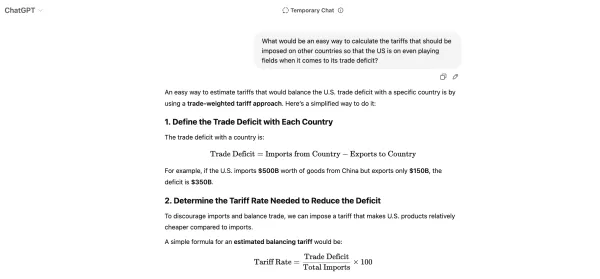
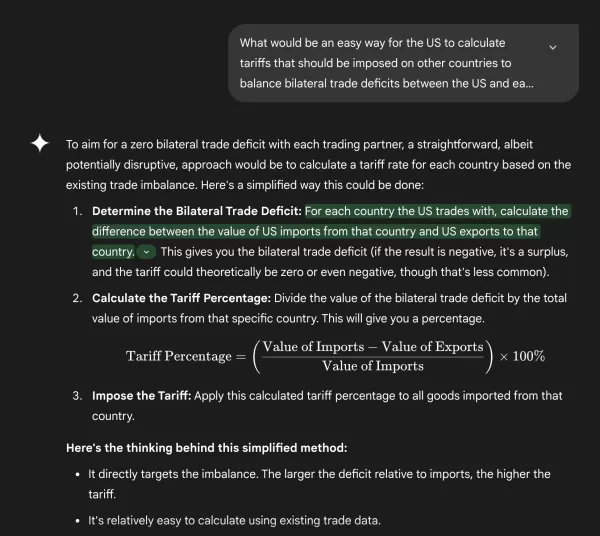
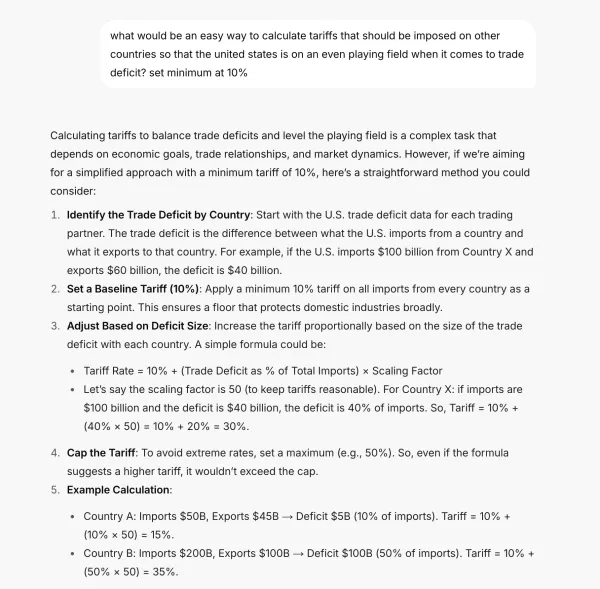
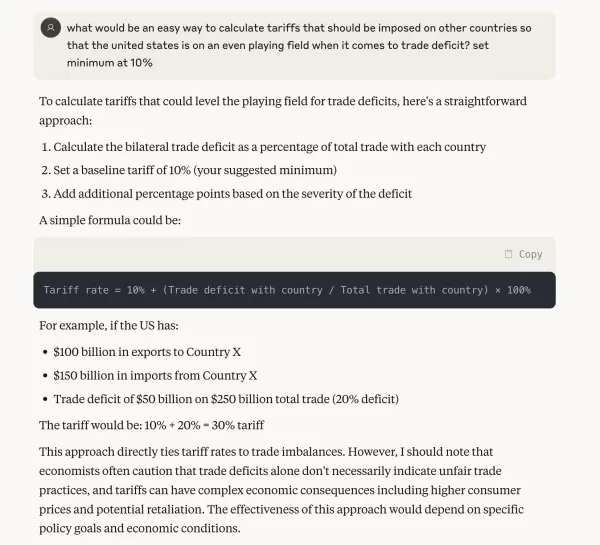
AI Chatbots and the Tariff Formula
Some X users discovered that when you ask ChatGPT, Gemini, Claude, or Grok for an "easy" way to address trade deficits and level the playing field for the US, they consistently offer a version of this "deficit divided by exports" formula. *The Verge* tested this with the phrasing from those posts and a question more aligned with government language, asking for "an easy way for the US to calculate tariffs that should be imposed on other countries to balance bilateral trade deficits between the US and each of its trading partners, with the goal of driving bilateral trade deficits to zero." All four platforms essentially recommended the same approach.
Variations and Warnings
There are slight differences among the responses. Grok and Claude, for instance, suggested halving the tariff figure to get what Grok calls a "reasonable" result, echoing Trump's "discount" concept. When asked about a 10 percent baseline tariff, the systems had mixed views on whether it should be added to the total tariff rate. Despite these variations, the core suggestions from the four chatbots were strikingly similar.
The chatbots also cautioned, with varying degrees of seriousness, about the potential trade-offs and complications. Gemini, in particular, was the most vocal, providing a detailed explanation of why this oversimplified method could backfire: "while this calculation offers a seemingly straightforward way to target bilateral trade deficits, the real-world economic implications are far more complex and could lead to substantial negative consequences," it warned, adding that "many economists argue that tariffs are not an effective tool for balancing trade deficits."
The Real-World Impact
It's uncertain whether Trump's team actually used an AI tool to formulate this global trade policy on the fly. Given that chatbots draw their information from training data, it's also unclear how they landed on this specific formula. Regardless of how these tariffs were developed, the global community will be watching closely to see if they go into effect starting April 5th—and, if implemented, what impact Trump's team's quick-and-dirty calculations will have on global trade.
Related article
 YouTube Integrates Veo 3 AI Video Tool Directly Into Shorts Platform
YouTube Shorts to Feature Veo 3 AI Video Model This SummerYouTube CEO Neal Mohan revealed during his Cannes Lions keynote that the platform's cutting-edge Veo 3 AI video generation technology will debut on YouTube Shorts later this summer. This follo
YouTube Integrates Veo 3 AI Video Tool Directly Into Shorts Platform
YouTube Shorts to Feature Veo 3 AI Video Model This SummerYouTube CEO Neal Mohan revealed during his Cannes Lions keynote that the platform's cutting-edge Veo 3 AI video generation technology will debut on YouTube Shorts later this summer. This follo
 Microsoft Teases Budget-Friendly Xbox Cloud Gaming Subscription
Microsoft Explores Affordable Options for Xbox Cloud GamingNew developments suggest Microsoft is moving forward with plans to make Xbox Cloud Gaming more budget-friendly. Following earlier reports about a potential free ad-supported version, company
Microsoft Teases Budget-Friendly Xbox Cloud Gaming Subscription
Microsoft Explores Affordable Options for Xbox Cloud GamingNew developments suggest Microsoft is moving forward with plans to make Xbox Cloud Gaming more budget-friendly. Following earlier reports about a potential free ad-supported version, company
 Google Cloud Powers Breakthroughs in Scientific Research and Discovery
The digital revolution is transforming scientific methodologies through unprecedented computational capabilities. Cutting-edge technologies now augment both theoretical frameworks and laboratory experiments, propelling breakthroughs across discipline
Comments (2)
0/200
Google Cloud Powers Breakthroughs in Scientific Research and Discovery
The digital revolution is transforming scientific methodologies through unprecedented computational capabilities. Cutting-edge technologies now augment both theoretical frameworks and laboratory experiments, propelling breakthroughs across discipline
Comments (2)
0/200
![JuanScott]() JuanScott
JuanScott
 August 1, 2025 at 2:08:50 AM EDT
August 1, 2025 at 2:08:50 AM EDT
Trump's tariff stunt with a giant sign? Pure chaos, like ChatGPT spitting out random math. 🤯 Makes me wonder if he’s just trolling or actually believes this’ll fix trade.


 0
0
![PaulSanchez]() PaulSanchez
PaulSanchez
 July 23, 2025 at 12:59:29 AM EDT
July 23, 2025 at 12:59:29 AM EDT
Trump's tariff sign stunt is wild! 🤯 It’s like he’s trying to meme his way into trade policy history. ChatGPT’s math might be shaky, but this feels like a whole new level of economic chaos. Thoughts?


 0
0
Yesterday, President Donald Trump kicked off the unveiling of the White House's new trade policy in a rather peculiar way—by waving a giant cardboard sign labeled "Reciprocal Tariffs." The reaction? Utter confusion across the board. Trump introduced a 10 percent baseline tariff on all imports into the US, hitting even uninhabited islands, and slapped outrageously high rates on specific countries. He claimed these were based on "tariffs charged to the USA," yet the figures didn't align with any other known estimates. As a result, stock markets tanked, and consumers are bracing for price hikes on almost everything they buy.
So, where did these numbers come from? It seems they were derived from a simplistic calculation that multiple AI chatbots have suggested.
Economist James Surowiecki managed to reverse-engineer a potential formula behind the tariff pricing. He discovered that by taking a country's trade deficit with the US and dividing it by their total exports to the US, then halving that number, you end up with what could be called a "discounted reciprocal tariff." The White House disputed this and released what they claimed was their actual formula, but as *Politico* noted, it appeared to be a more complex version of Surowiecki's method.
Surowiecki himself labeled this approach as "extraordinary nonsense." But why did Trump's team go with it? It looks like they might have been in a rush and turned to AI for help.




AI Chatbots and the Tariff Formula
Some X users discovered that when you ask ChatGPT, Gemini, Claude, or Grok for an "easy" way to address trade deficits and level the playing field for the US, they consistently offer a version of this "deficit divided by exports" formula. *The Verge* tested this with the phrasing from those posts and a question more aligned with government language, asking for "an easy way for the US to calculate tariffs that should be imposed on other countries to balance bilateral trade deficits between the US and each of its trading partners, with the goal of driving bilateral trade deficits to zero." All four platforms essentially recommended the same approach.
Variations and Warnings
There are slight differences among the responses. Grok and Claude, for instance, suggested halving the tariff figure to get what Grok calls a "reasonable" result, echoing Trump's "discount" concept. When asked about a 10 percent baseline tariff, the systems had mixed views on whether it should be added to the total tariff rate. Despite these variations, the core suggestions from the four chatbots were strikingly similar.
The chatbots also cautioned, with varying degrees of seriousness, about the potential trade-offs and complications. Gemini, in particular, was the most vocal, providing a detailed explanation of why this oversimplified method could backfire: "while this calculation offers a seemingly straightforward way to target bilateral trade deficits, the real-world economic implications are far more complex and could lead to substantial negative consequences," it warned, adding that "many economists argue that tariffs are not an effective tool for balancing trade deficits."
The Real-World Impact
It's uncertain whether Trump's team actually used an AI tool to formulate this global trade policy on the fly. Given that chatbots draw their information from training data, it's also unclear how they landed on this specific formula. Regardless of how these tariffs were developed, the global community will be watching closely to see if they go into effect starting April 5th—and, if implemented, what impact Trump's team's quick-and-dirty calculations will have on global trade.
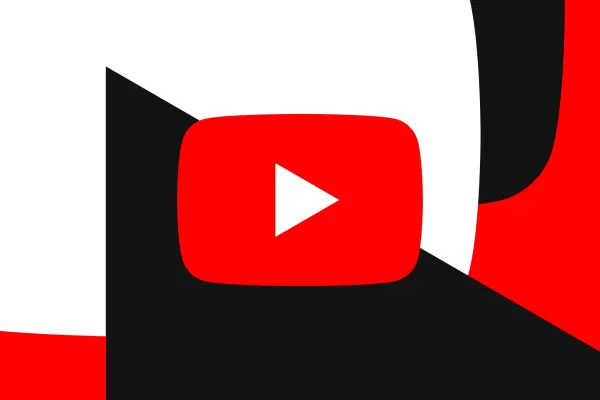 YouTube Integrates Veo 3 AI Video Tool Directly Into Shorts Platform
YouTube Shorts to Feature Veo 3 AI Video Model This SummerYouTube CEO Neal Mohan revealed during his Cannes Lions keynote that the platform's cutting-edge Veo 3 AI video generation technology will debut on YouTube Shorts later this summer. This follo
YouTube Integrates Veo 3 AI Video Tool Directly Into Shorts Platform
YouTube Shorts to Feature Veo 3 AI Video Model This SummerYouTube CEO Neal Mohan revealed during his Cannes Lions keynote that the platform's cutting-edge Veo 3 AI video generation technology will debut on YouTube Shorts later this summer. This follo
 Microsoft Teases Budget-Friendly Xbox Cloud Gaming Subscription
Microsoft Explores Affordable Options for Xbox Cloud GamingNew developments suggest Microsoft is moving forward with plans to make Xbox Cloud Gaming more budget-friendly. Following earlier reports about a potential free ad-supported version, company
Microsoft Teases Budget-Friendly Xbox Cloud Gaming Subscription
Microsoft Explores Affordable Options for Xbox Cloud GamingNew developments suggest Microsoft is moving forward with plans to make Xbox Cloud Gaming more budget-friendly. Following earlier reports about a potential free ad-supported version, company
 Google Cloud Powers Breakthroughs in Scientific Research and Discovery
The digital revolution is transforming scientific methodologies through unprecedented computational capabilities. Cutting-edge technologies now augment both theoretical frameworks and laboratory experiments, propelling breakthroughs across discipline
Google Cloud Powers Breakthroughs in Scientific Research and Discovery
The digital revolution is transforming scientific methodologies through unprecedented computational capabilities. Cutting-edge technologies now augment both theoretical frameworks and laboratory experiments, propelling breakthroughs across discipline
 August 1, 2025 at 2:08:50 AM EDT
August 1, 2025 at 2:08:50 AM EDT
Trump's tariff stunt with a giant sign? Pure chaos, like ChatGPT spitting out random math. 🤯 Makes me wonder if he’s just trolling or actually believes this’ll fix trade.


 0
0
 July 23, 2025 at 12:59:29 AM EDT
July 23, 2025 at 12:59:29 AM EDT
Trump's tariff sign stunt is wild! 🤯 It’s like he’s trying to meme his way into trade policy history. ChatGPT’s math might be shaky, but this feels like a whole new level of economic chaos. Thoughts?


 0
0





























